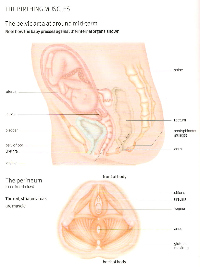A sphincter is a ring-shaped muscle that acts like a valve by squeeznig tightly around the botom of a tube to keep the contents in. Women have three such ‘tubes’ that are either sphincters or sphincter-like. These are the anal tube, the urethra and the muscles each side of the vagina.
With regular practice you can learn to contract or release these muscles at will, which will help you throughout the pregnancy:
- when your baby is pressing down against the pelvic floor
- during the birth to help control the baby’s movement down through the birth canal
- after the birth, to restore perineal muscle tone as quickly as possible, thus avoiding many postnatal problems
The exercise:
Yogic philosophy maintains that energy follows thought. By connecting breath with muscular action you are toning the muscles of the perineum, including those that attach it to the pelvis at the front and the lower spine at the back.
Kneel in the Cat pose with your knees spread wide enough to accommodate your baby as you lean forward on to your elbows. You can place your head on a cusion if it is more comfortable. Distribute your weight evenly between your elbows and knees so that your head and neck are comfortable and your coccyx is raised as high as possible.
- We begin the birthing muscle workout with the anal sphincter, contracting and releasing it in turn. You’ll learn how to draw the anus in on an inbreath and release it on an exhalation.
- After this focus on the urethric sphincter, squeezing and releasing it in small rapid movements.
- Finally focus on the vaginal muscles, squeezing them tightly to draw the pelvic floor up and in. You will feel that the lower abdomen is also drawn up and inward.
More in: Yoga for Pregnancy: The Safe and Gentle Way to Prepare your Body and Mind for Birth


No Comments